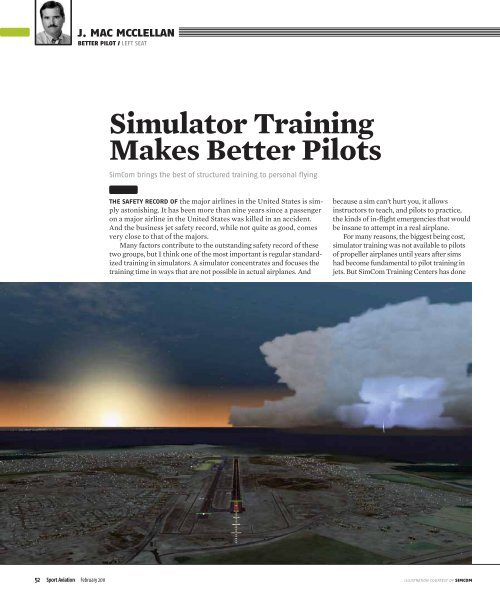Simulator Training Makes Better Pilots - Left Seat
Simulator Training Makes Better Pilots - Left Seat
Simulator Training Makes Better Pilots - Left Seat
Create successful ePaper yourself
Turn your PDF publications into a flip-book with our unique Google optimized e-Paper software.
J. Mac McClellanmore to change that than any other companyby building simulators for a range of propellersingles and twins. SimCom didn’t simplyadopt the jet-training concept wholesale, buttook the best of sim training and customized itto best suit the way an owner-pilot operates.I have been to SimCom several times overthe years for recurrent training in my Baron58 and have always been impressed by thelevel of personalization designed into thesystem. SimCom was created from scratch toserve the owner-pilot and the smaller flightdepartments. Maximum class size is twopilots with a dedicated instructor, meaningeveryone must participate at a high level, andthe instructor can be certain that each pilotunderstands the material. When I was therefor training last December I was the only onesigned up for the Baron for those days so theinstruction was one-on-one.A typical recurrent training sessionextends over three days with 12 hours spentin the simulator: six in the left seat, and sixmore observing from the right. If there isonly one pilot in the class, the training canbe completed in two days.Initial training courses for pilots new tothe airplane may take more time, dependingon the complexity of the airplane.SimCom also offers what it calls an“advanced refresher” course that is aimedat pilots who have been through severalrecurrent courses, and it can be customizedto the desires of the pilot.Ground school is never going to be a spellbindingexperience, but SimCom does a goodjob of delivering the information about yourairplane in an effective way. The printedmaterials are succinct and contain the informationthat you need to know to operateyour airplane and its systems, and to help introubleshooting failures, without wanderingoff into information you can’t really use, suchas the timing angle on the magnetos.Each SimCom classroom has a computerand projector that can display course materials,but it’s also connected to the Internet toshow any available online information.Making Peace With the Sim<strong>Simulator</strong>s don’t fly exactly like the airplanethey replicate. This fact drives most pilotsnew to sim training crazy. We know we cando okay in the real airplane, but the first fewtimes in the sim we really hack it up. Justholding heading and altitude and staying onthe target airspeed will be a challenge.The issue is that the sim can’t deliverevery subtle cue that the real airplanedoes. We don’t think of it when we’re flying,but there is a continuous sensoryinput of sounds, slight G-loading changes,and tiny feedback from the controls that ismissing in the simulator. Those cues helpus know the airplane attitude or airspeedis changing even when flying in the clouds,but many of those tiny sensations are missingin the sim.The result is that you must have anexcellent instrument scan to fly a simulatorwith precision. Of course, we can’t fly anyairplane, real or simulated, with our eyesclosed, but in the sim the scan isAIRCRAFT TOOLSUPPLY COMPANYToll Free: 1-800-248-0638New!HEAVY DUTY SPARK PLUG GAPPER KITWe now carry the complete spark plug gappingsolution for field or bench use!Our newest kit includes the ATS420 Professional HeavyDuty Spark Plug Gapping Tool to accurately set yourspark plug gaps to within 0.001”. You will also get a setof wire feeler gauges (p/n ATS450) to verify gap size. Ifyou should happen to accidentally over-gap the plug,then the included Gap Expansion Tool (p/n ATS483) willget you back on track. And finally, we’ve included anElectrode Erosion Gauge (p/n ATS482) to make sure thatyour gapped plugs are still in serviceable condition.Compatible with all Champion and AutoLite massiveelectrode spark plugs.The attractive Nickel-Cadmium finish resists rust andcorrosion. Our new Heavy Duty Spark Plug Gapper Kitwill be a welcomed addition to any toolbox or bench.www.aircraft-tool.comATS420DXATS450ATS420 ATS483 ATS482FebruarySport2011.indd 154 Sport Aviation February 20111/5/2011 9:54:04 AM
J. Mac McClellanSpark PlugsandOil filtersofChampionswww.tempestplus.comcan cause a cascade of events that, if nothandled properly, can leave you in a worldof hurt. My favorite is a generator or alternatorthat quits on one engine, and then theother engine fails entirely, leaving you withhalf the thrust and none of the generatingoutput. It could happen in real life, and doeshappen in simulators.Engine failures are a big part of sim training—ontakeoff roll, shortly after liftoff, incruise, and on final approach. You can counton having to attempt an engine-out go-aroundat least once during the course in a twin.Any pilot, even those who don’t fly twins,could tell you how to handle an engine failure.Step on the rudder hard to stop the yaw towardthe dead engine, roll in as much aileron asneeded to keep the wings close to level, andthen feather the propeller on the failed engineto get rid of the drag. What the sim does is takethis intellectual knowledge of how to deal withthe emergency and transform it into actions. Nomatter how well you know the procedure inyour head, getting your hands and feet to do theright thing at the right time takes practice thatcan only be done at low altitudes and in criticalsituations safely in a sim.Even in the singles such as the TBM andPilatus turboprops at SimCom, engine failure isan important part of the training. Restarts mustbe considered and the glide must be managedto optimize your chances in the forced landing.I even had both engines fail in the Baron,which is part of the training syllabus. Thedrill is, of course, to feather both propsimmediately to optimize the glide, but afterthat it’s the usual forced landing drill. Icouldn’t make it back to one of Orlando’srunways so I opted for a lake and took mychances Sully style. It was a crash, but I thinkI would have survived; at least I had betterchances than hitting the crowded residentialstreets and homes around the lake.Vision Equals MotionSimCom uses both full-motion Level C simulatorsand fixed sims that are technicallycalled flight-training devices. Most of thepropeller airplanes are the fixed type, butthey are different than most because of hugevisuals displayed on 8-foot-high screensahead of the actual airplane cockpit. Thescreens wrap around the full 90 degrees tothe left, and about 60 degrees to the right.The size of the visual displays, and theirdistance ahead of the windshield, produce anoverpowering sensation of motion. The resolutionand detail have been recentlyupgraded, so you can fly daylight, dusk, ornight. The quality of the display is so good it’seasy to fly the sim visually, which is not trueof units that have small visual displays.The qualities of the simulator are importantin any sim training, but that is not the mostcrucial issue. What really counts is the structureof the training that SimCom and othersimulator-based training schools offer. FlyingIFR is all about discipline, and that is learnedbest in a structured environment. If you don’tbelieve me, look at the safety record of the jetpilots who routinely train in sims.J. Mac McClellan, EAA 747337, has been a pilot formore than 40 years, holds an airline transport pilotcertificate, and owns a Beechcraft Baron. Mac is also writingan online blog at http://MacsBlog.com56 Sport Aviation February 2011PHOTOGRAPHY courtesY simcom




